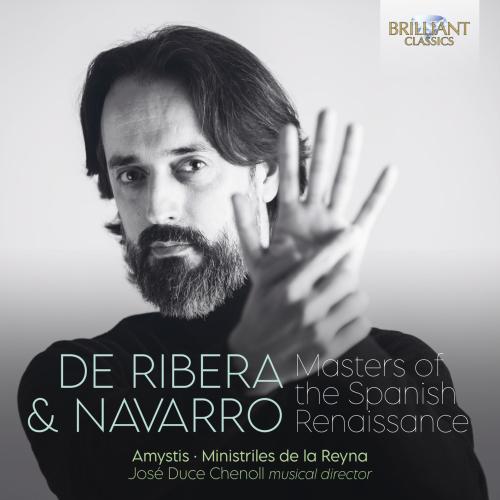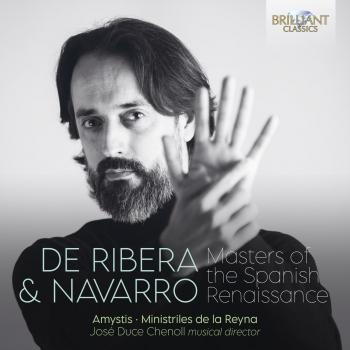
De Ribera & Navarro: Masters of the Spanish Renaissance Amystis, Ministriles de la Reyna & José Duce Chenoll
Album Info
Album Veröffentlichung:
2022
HRA-Veröffentlichung:
05.08.2022
Label: Brilliant Classics
Genre: Classical
Subgenre: Vocal
Interpret: Amystis, Ministriles de la Reyna & José Duce Chenoll
Komponist: Bernardino de Ribera (1520-1580), Juan Navarro (1530-1580), Sebastian de Vivanco (1551-1622), Tomas Louis de Victoria (1548-1611)
Das Album enthält Albumcover Booklet (PDF)
- Bernardino De Ribera (1520 - 1580): Vox in Rama:
- 1 Ribera: Vox in Rama 03:46
- Beata Mater:
- 2 Ribera: Beata Mater 03:05
- Dimitte me ergo:
- 3 Ribera: Dimitte me ergo 03:22
- Juan Navarro (1530 - 1580): Laboravi in gemitu meo:
- 4 Navarro: Laboravi in gemitu meo 03:14
- Ave regina:
- 5 Navarro: Ave regina 03:11
- Codex Santiago, Work Without Text:
- 6 Navarro: Codex Santiago, Work Without Text 02:32
- Ecce ascendimus hierosolimam:
- 7 Navarro: Ecce ascendimus hierosolimam 02:55
- Erat Iesus eiiciens daemonium:
- 8 Navarro: Erat Iesus eiiciens daemonium 02:24
- Simile est regnum caelorum:
- 9 Navarro: Simile est regnum caelorum 03:00
- Sebastián De Vivanco (1551 - 1622): Magnificat 1º tono:
- 10 Vivanco: Magnificat 1º tono 10:39
- Sanctorum meritis:
- 11 Vivanco: Sanctorum meritis 01:44
- Tomás Luis De Victoria (1548 - 1611): Salve regina a 8:
- 12 Victoria: Salve regina a 8 08:26
Info zu De Ribera & Navarro: Masters of the Spanish Renaissance
With their previous albums for Brilliant Classics, the Amystis ensemble of singers and instrumentalists have won a following for their exploration of lesser-known sacred and secular masterpieces from the Spanish Golden Age of the 16th century.
Tomás Luis de Victoria is the acknowledged master of that period, but relatively little attention has been paid to his childhood and youth, growing up as a chorister in Avila. The music directors of the cathedral at that time, instructing the boy Victoria, were Bernardino de Ribera and his successor Juan Navarro, and so it is especially original and enlightening to hear their music alongside that of their student and one of his contemporaries from Avila, Sebastian de Vivanco, building up a picture of devotional culture in the city from the second half of the 16th century.
The album is launched in splendid style by a trio of motets by Ribera, including the Palm Sunday introit Vox in Rama. Five works by Navarro receive world-premiere recordings, including his intensely expressive setting of the penitential text Laboravi in gemitu meo. As well as a Magnificat by Vivanco there is also a first recording for his Sanctorum meritis, and the album’s climax arrives with the familiar mastery of the Salve Regina by Victoria.
Under their founder-director José Duce Chenoll, the members of Amystis sing with a single voice to a part, producing consort performances which are acutely sensitive to the ebb and flow of the polyphony and the meaning of the text. The booklet includes an essay by Chenoll on the theme and historical context of the album, as well as sung texts and translations.
‘I wanted to opt for the most realistic sound possible, unsweetened, raw,’ says Chenoll: ‘I wanted to make the listener perceive the polyphony not only in its structural component but also in its spiritual one. Those who listen to this recording will be able to feel what I felt during its performance, they will be able to experience the music as it resounded in the space where it was recorded and will perceive a spatial, almost spiritual sensation beyond the music itself.’
This new recording presents two composers who stood at the cradle of the Golden Age of Spanish Renaissance, Bernardino de Ribera (c.1520- c.1580) and Juan Navarro (c.1530-1580). Both were connected to the Cathedral of Avila and in their musical capacity they were the teachers of several masters-to be, among them the great Tomas Luis de Victoria. During his early musical years, Victoria sang the music of Ribera and Navarro on a daily basis, and they taught him everything he needed to know about polyphony, singing, counterpoint and organ playing. This disc presents also works by de Victoria and Sebastian de Vivanco.
Superb performances by the Spanish vocal ensemble Amystis, specialized in presenting hidden gems from the Spanish Renaissance and Baroque. Their previous recordings for Brilliant Classics with works by Cabanilles and Comes gained excellent critical acclaim in the international press. Early Music Review: ‘Amystis are worthy exponents of this glorious music, negotiating its considerable complexity with aplomb.
Amystis
Ministriles de la Reyna
José Duce Chenoll, musical director
Keine Biografie vorhanden.
Booklet für De Ribera & Navarro: Masters of the Spanish Renaissance










